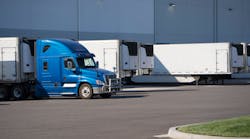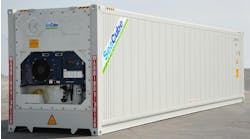Cold chain considerations: Shipping perishables FOB vs. LTL
Protecting in-transit perishable shipments is a goal shared by stakeholders throughout the cold chain. Producers and growers (aka shippers) want to maintain products at their pre-cooled and/or frozen temperature setpoints. Carriers (i.e., truck drivers) and transport teams are tasked with delivering product to retailers on time and in optimum condition. Retailers depend on the receipt of a continuous stream of fresh and safe produce, protein, and floral offerings to keep consumers engaged and profits steady.
And although each stakeholder plays a key role in the shipping process, ownership depends on the methods in which products are shipped. With free on board (FOB) shipments, retailer transport teams take ownership of the product the minute it is loaded onto the truck. In contrast, less-than-truckload (LTL) shipments (aka delivered loads) are owned by the shipper until the product reaches the retail DC or destination.
Regardless of shipping method, responsible parties face legal ramifications when the delivered product shows signs of temperature abuse. For FOB shipments, claims disputes are likely directed to the shipper or carrier. In LTL shipments—where retailers are the product owners—the shipper, carrier, and sometimes the receiver are potentially responsible when product shows signs of temperature abuse or mishandling.
In any case, having a third-party logging and/or real-time tracking device is imperative for monitoring temperatures during shipment. Emerson GO loggers and real-time trackers are used to provide an objective record of conditions with which to settle disputes. Today, many retailers require the use of these devices to ensure quality, whether they’re using their own internal distribution center (DC) transport teams or partnering with third-party logistics carriers.
Understanding the differences between FOB and LTL shipping models is the first step in developing proper quality control programs—of which there are two primary types:
- Temperature control for safety (TCS) focuses on preventing the formation of bacteria and the potential for foodborne illness.
- Temperature control for quality (TCQ) is concerned with minimizing food shrink and maximizing the shelf life, freshness, taste and appearance of perishable products.
At the end of the day, maintaining food quality and safety is a goal shared by all stakeholders in the perishable supply chain. But by considering the inherent risks, challenges and characteristics of FOB versus LTL shipping methods, stakeholders can better achieve their individual and collective goals.
FOB—More control and predictability
For retailers, building an FOB truckload offers them more control and predictability over their perishable shipments of fresh produce. In most instances, FOB trucks are loaded within proximity to high-volume growing regions (e.g., Salinas, Calif.). This offers many advantages that contribute to preserving perishable quality, including:
- Filling trucks within a short timeframe, because different types of fresh produce (e.g., lettuce, grapes, broccoli, berries, etc.) can be found within a short distance of each other.
- Selecting and shipping produce that have similar temperature ranges.
- Arranging and balancing truckloads according to best stacking and airflow practices; achieving optimal freight weight distribution.
- Shipping directly to a DC in the quickest manner possible.
Because many retailers run their own transport and DC networks, they’re better able to keep close tabs on their FOB shipments — including in-transit temperatures, delivery times and truck unloading efficiencies. Since retailers have more control over their FOB shipments, they typically utilize third-party temperature loggers as standard practice in their TCQ programs. These devices enable retailers to keep historic records of each shipment, which are downloaded on arrival at DCs.
LTL—Higher stakes, more disruptions and less control
LTL loads introduce additional temperature control and logistical challenges, mainly because loads are built with lower quantities (aka less-than-truckload) and more varieties of high-value perishable products. This wide variety of fresh, chilled, and frozen products presents higher risks to safety, contamination or degradation.
Because LTL loads are “delivered loads”—where retailers can accept or reject ownership upon delivery—many retailers leave quality initiatives in the hands of shippers or carriers. Although LTL loads are more difficult to maintain proper holding temperatures, they are the least likely to utilize third-party temperature tracking devices. Unfortunately, this makes LTL loads a greater risk for temperature abuse and shipping errors that could impact product shelf life, quality, and safety.
The unpredictable nature of LTL loads contributes to quality challenges. Quality and safety issues can occur when multiple types of perishables—with different holding temperatures and handling requirements—are loaded on the same truckload. With LTL loads, loading and unloading processes are inherently more complicated, where frequent and prolonged opening of refrigerated trailer doors can cause temperatures to rise.
LTL Loads can take longer to build—sometimes multiple days—which can extend the time needed to maintain proper refrigerated trailer temperatures and potentially shorten product shelf lives once they arrive in stores. In addition, LTL built loads may result in more random loading configurations, causing airflow, stacking and freight balancing issues.
In addition, 90% of carriers are independent truck owners. To save on fuel expenses, many do not keep the refrigeration unit on continuous cooling mode. Instead, cycle sentry mode is often used, which can cause temperature variations. Even if a trailer stays below the setpoint temperatures, these temperature swings place stress on product, causing degradation and shortening shelf life.
Because of all these variables with LTL shipments, stakeholders should always use real-time, third-party tracking devices to anchor their TCS initiatives. When combined with cloud-based cargo monitoring software, this gives stakeholders live notifications of temperature abuse, while providing a record of shipment activities and conditions to help resolve claims and disputes.
Implement proper quality and safety initiatives
Emerson GO real-time trackers and loggers—combined with our Oversight cargo software and value-added services—provide stakeholders with the assurance they need to help prevent temperature abuse. For real-time visibility and the added protection of high-value LTL loads, GO real-time trackers can help retailers protect product safety and track delivery times to meet consumer demand.
Both GO loggers and real-time trackers provide objective records of refrigerated trailer temperatures throughout transit, serving as the backbone of TCQ and TCS programs for perishable shipments.
Doug Thurston is the vice president of sales for cold chain cargo solutions at Copeland.





